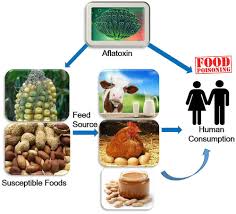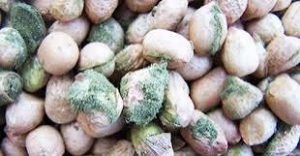
 Aflatoxins are derivatives of fungal metabolism from species of Aspergillus flatus and Aspergillus parasiticus which contaminates staples, cereals, and oil seeds, such as maze and ground nuts.
Aflatoxins are derivatives of fungal metabolism from species of Aspergillus flatus and Aspergillus parasiticus which contaminates staples, cereals, and oil seeds, such as maze and ground nuts.
Contamination occurs during cultivation and post harvest handling such as poor storage conditions and high humidity and temperature which encourages the growth and production.
The maximum concentration deemed safe by WHO is only 10 ppb.
Aflatoxin causes liver cancer in humans and other animal species.
Aflatoxin is synergistic with chronic infection with hepatitis B virus to greatly increase liver cancer risk.
Aspergilli are warm weather fungi, and dietary aflatoxin exposure is highest on populations living in tropical or subtropical regions of the world which consume maze and peanuts as dietary staples.
sub Saharan Aflatoxins are various poisonous carcinogens and mutagens that are produced by certain molds, particularly Aspergillus species mainly by Aspergillus flavus and Aspergillus parasiticus.
The fungi grow in soil, decaying vegetation and various staple foodstuffs and commodities such as hay, maize, peanuts, coffee, wheat, millet, sorghum, cassava, rice, chili peppers, cottonseed, tree nuts, sesame seeds, sunflower seeds, and various cereal grains and oil seeds. In short, the relevant fungi grow on almost any crop or food.
When such contaminated food is processed or consumed, the aflatoxins enter the general food supply.
They have been found in both pet and human foods, as well as in feedstocks for agricultural animals.
Animals fed contaminated food can pass aflatoxin transformation products into milk, milk products, and meat.
Children are particularly vulnerable to aflatoxin exposure, which is linked to immune suppression, stunted growth, delayed development, aflatoxicosis, food spoilage and liver cancer.
Some studies have reported an association between childhood stunting and aflatoxin exposure.
Adults have a higher tolerance to exposure to aflatoxin, but are also at risk.
No animal species is known to be immune to aflatoxin.
Aflatoxins are among the most carcinogenic substances known.
Aflatoxins may be metabolized by the liver to a reactive epoxide intermediate or hydroxylated to become the less harmful aflatoxin M1.
Aflatoxin poisoning most commonly results from ingestion, but the most toxic aflatoxin compound, B1, can permeate through the skin.
The United States Food and Drug Administration (FDA) action levels for aflatoxin present in food or feed is 20 to 300 ppb.
The term “aflatoxin” is derived from the name of the species Aspergillus flavus, in which some of the compounds first were discovered.
Aflatoxin B1 is considered the most toxic and is produced by both Aspergillus flavus and Aspergillus parasiticus.
Aflatoxin M1 is present in the fermentation broth of Aspergillus parasiticus, but it and aflatoxin M2 are also produced when an infected liver metabolizes aflatoxin B1 and B2.
Aflatoxin M1 (AFM1), metabolite of aflatoxin B1 in humans and animals may come from a mother’s milk.
Aflatoxins are produced by both Aspergillus flavus and Aspergillus parasiticus, which are common forms of molds widespread in nature.
The molds can colonize and contaminate food before harvest or during storage, especially following prolonged exposure to a high-humidity environment, or to stressful conditions such as drought.
Aflatoxin contamination is increasing in crops such as maize as a result of climate change creating better conditions for these molds.
Aspergillus’s native habitat is in soil, decaying vegetation, hay, and grains undergoing microbiological deterioration, but it invades all types of organic substrates whenever conditions are favorable for its growth.
Favorable conditions for production of aflatoxins include high moisture content (at least 7%) and temperatures from 55 to 104 °F (13 to 40 °C) with optimum 27 to 30 °C (81 to 86 °F)].
Aflatoxins have been isolated from all major cereal crops, and from sources as diverse as peanut butter and cannabis.
The staple commodities regularly contaminated with aflatoxins include cassava, chilies, corn, cotton seed, millet, peanuts, rice, sorghum, sunflower seeds, tree nuts, wheat, and a variety of spices intended for human or animal consumption.
Aflatoxin products are sometimes found in eggs, milk products, and meat when animals are fed contaminated grains.
The practices for drying and storage of maize are inadequate in minimizing exposure to aflatoxins.
Organic crops, which are not treated with fungicides, may be more susceptible to contamination with aflatoxins.
Limiting risk from aflatoxins in the food supply is food hygiene: rejecting moldy grain for use in food processing plants and testing of batches of ingredients for aflatoxin levels before adding them to the mix.
The FDA set limits on acceptable levels.
Grain drying itself, which is necessary for viable combine harvesting in many regions, lays the fundamentals for this effort by preventing stored grain from being too damp in the first place.
No animal species is known to be immune to the acute toxic effects of aflatoxins.
Humans have a high tolerance for aflatoxin exposure and rarely succumb to acute aflatoxicosis, but children are particularly affected, and their exposure can lead to stunted growth and delayed development
High-level aflatoxin exposure produces an acute hepatic necrosis resulting later in cirrhosis or carcinoma of the liver.
Acute liver failure is made manifest by bleeding, edema, alteration in digestion, changes to the absorption and/or metabolism of nutrients, and mental changes and/or coma.
Chronic, subclinical exposure does not lead to symptoms so dramatic as acute aflatoxicosis.
Chronic exposure increases the risk of developing liver and gallbladder cancer, as aflatoxin metabolites may intercalate into DNA and alkylate the bases through its epoxide moiety.
Exposure is thought to cause mutations in the p53 gene.
The p53 gene is an important gene in preventing cell cycle progression when there are DNA mutations, or programmed cell death.
Aflatoxin B1 can cause immune suppression, and is associated with an increased viral load in HIV positive individuals.
Aflatoxin-related diseases vary by species, age, nutrition, sex, and the possibility of concurrent exposure to other toxins.
Its main target organ in mammals is the liver.
The likelihood of aflatoxicosis includes: limited availability of food, environmental conditions that favor mold growth on foodstuffs, and lack of regulatory systems for aflatoxin monitoring and control.
A diet including vegetables, such as carrots, parsnips, celery, and parsley may reduce the carcinogenic effects of aflatoxin.
No specific antidote for aflatoxicosis exists.
Care is symptomatic and supportive, and tailored to the severity of the liver disease and includes intravenous fluids with dextrose, active vitamin K, B vitamins, and a restricted, but high-quality protein diet with adequate carbohydrate content.
There are two principal techniques that have been used most often to detect levels of aflatoxin:
Measuring the AFB1-guanine adduct in the urine of subjects.
The presence of this breakdown product indicates exposure to aflatoxin B1 during the past 24 hours.
Measurement of the AFB1-albumin adduct level in the blood serum provides a measure of exposure over several weeks or months.
Sources of commercial peanut butter, cooking oils (e.g. olive, peanut and sesame oil), and cosmetics have been identified as contaminated with aflatoxin.
In 1973 Poland: 10 died following the opening of the tomb of Casimir IV Jagiellon, which contained aflatoxin-producing molds.
2004 Kenya: acute outbreak of aflatoxicosis resulting from ingestion of contaminated maize, 125 confirmed deaths.
2021 US: Contamination of pet food manufactured by Midwestern Pet Food, causing the deaths of at least 70 dogs.
